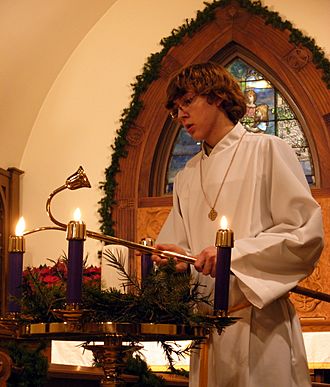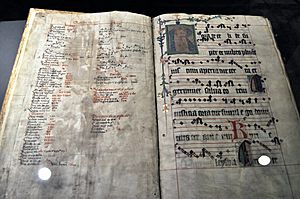Advent facts for kids
Quick facts for kids Advent |
|
|---|---|

An acolyte lighting Advent candles
|
|
| Observed by | Christians |
| Type | Christian, cultural |
| Significance | Preparation for the commemoration of the birth of Jesus |
| Observances | Church services, completing an Advent calendar and Advent wreath, praying through a daily devotional, erecting a Chrismon tree, hanging of the greens, lighting a Christingle, gift giving, family and other social gatherings |
| Begins | Fourth or (in the Ambrosian and Mozarabic Rites) sixth Sunday before Christmas |
| Date | 3 December 2023 |
| Frequency | Annual |
| Related to | Christmastide, Christmas Eve, Annunciation, Epiphany, Epiphanytide, Baptism of the Lord, Nativity Fast, Nativity of Jesus |
Advent is a special time of year for Christians. It begins on a Sunday about four weeks before Christmas Day. Many Christian churches and groups celebrate Advent.
It's a time for Christians to get ready for two important things. First, they prepare to celebrate the birth of Jesus at Christmas. Second, they remember Jesus's future return to Earth, when he will bring peace to everyone.
Some people use Advent for quiet reflection. They might spend time in prayer, meditation, or studying religious texts.
Special Advent calendars are popular for children. These calendars have pictures or small treats for each day leading up to Christmas. Many homes also have an Advent wreath with four candles.
In many Catholic and Protestant churches, the candles are usually violet and rose (pink). Other Protestant churches, especially in the United Kingdom, often use four red candles. Each Advent Sunday, one more candle is lit. By the fourth week, all four candles are burning. This symbolizes Jesus as the "light of the world" who is coming at Christmas. Sometimes, a fifth white candle is placed in the middle of the wreath.
Advent is also a busy time for many families. They get ready for Christmas Day by cleaning, decorating, buying food and gifts, writing cards, and preparing a big Christmas meal.
Contents
When Did Advent Begin?
It's not exactly known when Advent started. However, we know it was definitely being celebrated around the fifth century (the 400s).
Advent Colors
Since about the 1200s, the main color for Advent in Western Christianity has been violet or purple. You might see this color on cloths that cover altars or on the special clothes worn by clergy (church leaders).
On the third Sunday of Advent, called Gaudete Sunday, a rose (pink) color might be used instead. This color represents joy. A pink candle is often lit on the Advent wreath on this Sunday.
In Eastern Christianity, red is often used during the Nativity Fast, which is similar to Advent. Gold can also be an alternative color.
Advent Music
Many churches have special musical events during Advent. These might include concerts like "Nine Lessons and Carols" or performances of Handel's Messiah. Certain traditional songs, like the "Advent Prose," are also sung. The week before Christmas, from December 17-24, is known for singing the "Great Advent 'O antiphons'."
Advent Traditions Around the World
In the past, in England, poor women would carry around "Advent images." These were two dolls dressed as Jesus and the Blessed Virgin Mary. People would give them a small coin, and it was thought to bring bad luck if a house wasn't visited by Christmas Eve.
In Normandy, France, farmers used to have children under twelve run through fields and orchards with torches. They would set fire to bundles of straw. People believed this would scare away pests that could harm their crops.
In Italy, a special Advent tradition involves pifferari, or bagpipe players, coming into Rome. They play music in front of shrines dedicated to Mary, Jesus's mother. Italian tradition says that shepherds played these pipes when they visited baby Jesus in the manger at Bethlehem.
Today, the most common Advent traditions outside of church are the Advent calendar and advent candle. With a calendar, you open one door each day in December until Christmas Eve. With an Advent candle, you burn a small section each day. In many countries, the first day of Advent also marks the start of the Christmas season. Many people put up their Christmas trees and decorations around this time.
The Advent Wreath

Having an Advent wreath is a common practice in homes and churches. The idea of the Advent wreath started with German Lutherans in the 1500s. However, the modern Advent wreath we know today developed much later.
The modern Advent wreath, with its candles for each Sunday of Advent, came from a German pastor named Johann Hinrich Wichern in 1839. He worked with poor children and noticed they were very impatient for Christmas. So, he made a wooden ring with nineteen small red candles and four large white ones. He lit a small candle every morning and a large one every Sunday. Today, we usually only use the large candles.
The wreath is traditionally made from fir tree branches. It's often decorated with a red ribbon, pine cones, holly, and laurel. The wreath itself has many meanings:
- Its round shape represents the sun and its yearly return, and also God's never-ending love.
- The number four stands for the four Sundays of Advent.
- The green branches are a sign of life and hope.
- Fir trees symbolize strength, and laurel represents victory. Holly, like fir and laurel, stays green all year, showing God's eternal nature.
- The candle flames represent the light of Christmas getting closer. They bring hope and peace, and symbolize fighting against darkness. For Christians, the wreath also reminds them of Christ the King, and the holly can represent the crown of thorns Jesus wore.
The Advent wreath usually has three violet or purple candles and one pink candle. The pink candle is lit on the Third Sunday of Advent, called "Gaudete Sunday" (meaning "Rejoice"). Some wreaths also have a fifth white candle in the middle, called the "Christ candle." This candle is lit on Christmas Eve or Christmas Day.
The candles can symbolize different things. One idea is that they represent important steps in history before Jesus came. The first candle might be for forgiveness given to Adam and Eve. The second for the faith of Abraham. The third for the joy of David. And the fourth for the teachings of the prophets who spoke of a time of justice and peace. Another idea is that they symbolize four stages of human history: creation, Jesus's birth, the forgiveness of sins, and the Last Judgment.
In Orthodox churches, Advent wreaths sometimes have six candles. This matches their six-week Advent period, called the Nativity Fast.
In Sweden, white candles are used to celebrate Saint Lucy's Day on December 13. This day always falls during Advent. White symbolizes celebration and purity.
See also
 In Spanish: Adviento para niños
In Spanish: Adviento para niños
Images for kids








